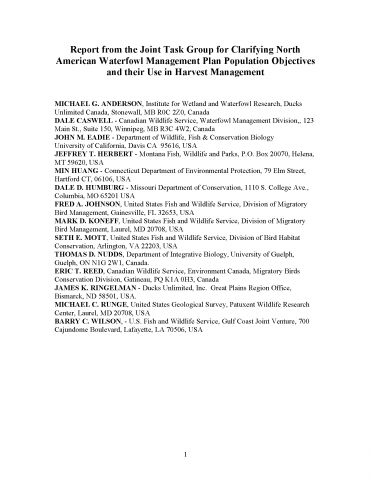
This report addresses one of the most fundamental debates in waterfowl policy and management -- the relative roles of habitat conservation and harvest regulation. The original framers of the North American Waterfowl Management Plan (Plan) recognized the inherent linkages among harvest, habitat, and hunters. The Plan set the stage for the next two decades of waterfowl conservation, during which managers demonstrated a capacity to deliver habitat initiatives through joint ventures, developed a technical framework for harvest management, and became increasingly aware of the role of stakeholders, especially hunters. To date, however, the waterfowl management community has not explicitly integrated these elements under a cohesive framework.
Recommendations from the Joint Task Group are intended to motivate the policy decisions and the technical work necessary to unite all aspects of waterfowl management.
Implementation of these recommendations will require communication and coordination among diverse internal and external stakeholders, completion of new technical
assessments for habitat and harvest management, the addition of technical capacity in the area of human dimensions, and leadership from agencies with mandated responsibility for waterfowl management. Six primary recommendations include:
- The U.S. Fish and Wildlife Service (FWS) and Canadian Wildlife Service (CWS), in consultation with the Flyway Councils, should adopt a “shoulder strategy” for northern pintails and mid-continent mallards. The principles of coherence and integration should be central components of the revised U.S. federal EIS on waterfowl harvest,
- The Plan Committee should adopt the same “shoulder strategy” to ensure coherence between harvest policy and habitat objectives, and focus the attention of the joint ventures on the conservation actions designed explicitly to enhance continental carrying capacity (K). The principles of coherence and integration should be central components of the 2009 Update of the Plan.
- The federal wildlife services, together with interested partners, must commit to enhancing technical capacity for the Plan’s Science Support Team (NSST) and the Adaptive Harvest Management Working Group (AHMWG) as both will have key roles in the technical integration of waterfowl management.
- The waterfowl management community must focus more scientific efforts on reducing the key ecological uncertainties surrounding current models of population dynamics (e.g., density dependence) and the relationships between waterfowl vital rates, carrying capacity (K), and landscape properties that habitat managers strive to manipulate.
- The FWS and CWS directorates should convene a waterfowl management policy summit in the near future to address the decisions necessary to develop the policy framework for habitat and harvest management integration.
- A new Human Dimensions Working Group (HDWG) should be convened to refine an assessment of waterfowl stakeholder values and the approach for more explicitly incorporating this information into management decisions.
